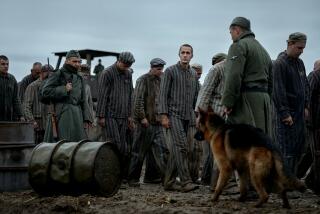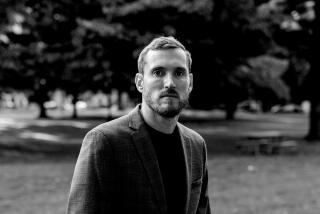To Occupied France, in Search of Meaning
- Share via
There is a magic surrounding Charlotte Gray. A blond-haired, blue-stockinged Scottish lass, she travels down to the bombed-out London of 1942 with the determination to put her brains to work for the war effort. Intense, intelligent and innocent, Charlotte falls in love with an RAF pilot named Peter Gregory and, after his plane disappears, volunteers as a courier to track him down in occupied France.
That magic, combined with her accentless French, her love of Proust, and the wet soil smell of France, helps her survive the following months, dodging German soldiers and French collaborators, while rescuing Jewish children and resisters, in a determined search to find Gregory. Sad to report, the magic stops there.
English author Sebastian Faulks has followed up the international success of his World War I novel “Birdsong” with “Charlotte Gray,” which focuses Faulks’ eye to detail to World War II. And yet, research notwithstanding, his eye seems to have wandered along the lazy path of cliche, making the novel read, at times, like an after-tea speech in the House of Commons.
Take Gregory, philosophizing on the magic that has preserved him through three years of flying. “Those with whom he had joined and those he met in the first months, who became in the strain of mutual reliance even closer to him than his original friends, were all gone. He had been to their funerals, one after the other, or sent his commiserations to their grieving parents when he could not go, and he felt that now he was alone, the guardian of what they had all once been.” Perhaps there is a corner of England’s green and pleasant land where some patriot can still twist his lips around the steak and kidney of such locutions, but these phrases play hard in Peoria.
The heroine fares little better. Unlike Susan Traherne of British playwright David Hare’s “Plenty,” who also finds her raison d’e^tre in wartime France, Charlotte Gray is a dabbler in the fields of passion. References to her childhood depression and her student reading of Proust fail to increase her stature and only make us feel the lumps in the analyst’s couch and the uncooked bits in the madeleine.
Worst of all, however, is Faulks’ treatment of that corner of World War II known as the Holocaust. An argument has circulated, almost since the liberation of the concentration camps, that enough has been written about the Holocaust and World War II in general. Sometimes the motive has been an anti-Semitism, sometimes a skepticism over the power of words. The true horror of “Charlotte Gray” is that it puts ammunition in the cannons of this latter camp. Never have the deaths of children and old men sounded so hollow. Every writer writes in the belief that he or she is communicating something brave and new to the world. But an artist who tackles the Holocaust--perhaps as a “guardian of what they had all once been”--has the added responsibility (as Roberto Benigni proved in his startlingly original “Life Is Beautiful”) to deliver on that belief.
More to Read
Sign up for our Book Club newsletter
Get the latest news, events and more from the Los Angeles Times Book Club, and help us get L.A. reading and talking.
You may occasionally receive promotional content from the Los Angeles Times.







